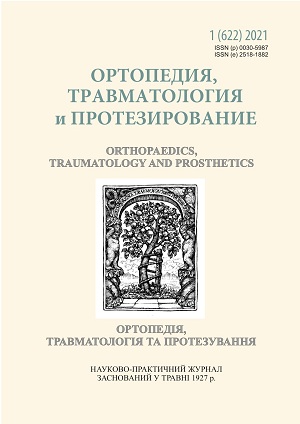The value of the plate mechanical properties in a case of thoracoplasty at the congenital pectus excavatum
DOI:
https://doi.org/10.15674/0030-59872021118-22Keywords:
Plate, mechanical properties, thoracoplastyAbstract
Surgical treatment of a congenital pectus excavatum (CPE) includes using of a plate that holds the correct anatomical shape of the chest for a long time. Before implanting the plate behind a sternum, it is bent so that after correcting the deformation, it reproduces shape of the ribs on both sides and fits close to them. Displacement and rotation are the most frequent complications after plate implantation. Therefore, mechanical properties of the plate, such as: strength, ability to withstand the load during surgery and in the long term period — is one of the main guarantees to obtain the good result. Objective. To study the mechanical properties of the plate which is used for thoracoplasty at CPE under conditions comparable to real loads in order to gain maximal correction. Methods. Experimental bending tests were performed on 5 standard plates of 2.5 mm thick, 13 mm width and 200 mm length, made from titanium Ti6–AL4–V (according to ISO 5832-3). All plates were bent with a special surgical instrument according to the anatomical shape of a chest, using method of surgery by D. Nuss. All plates supports were placed on a distance from the fixing screws. The force of bending load was applied to the middle of the plate, gradually increasing from 150 to 600 H with a step 50 H. At each value of the loading we measured the height of the plate edge elevation. Results. Under load conditions of 600 H, the elevation of a plate edge did not exceed 3 mm and was equal to (2700 ± 177) μcm. In a case of twice lower loads (300 H), value of lifting edge of the plate decreased in three times and was (700 ± 85) μcm. Changes that happened under loading were the same for all five types of the plate. Conclusions. It is proved that the plates can fully withstand corrective loads with a minimal deformation after thoracoplasty. The discrepancy between the plate shape in the lateral parts to the restored thorax is caused by the changing of configuration of the last one and increasing in the anteroposterior size. Key words. Plate, mechanical properties, thoracoplasty.
References
- Guo, L., Mei, J., Ding, F., Zhang, F., Li, G., Xie, X., Hu, F., & Xiao, H. (2013). Modified Nuss procedure in the treatment of recurrent pectus excavatum after open repair. Interactive CardioVascular and Thoracic Surgery, 17(2), 258-262. https://doi.org/10.1093/icvts/ivt150
- Kelly, R. E., Goretsky, M. J., Obermeyer, R., Kuhn, M. A., Redlinger, R., Haney, T. S., Moskowitz, A., & Nuss, D. (2010). Twenty-one years of experience with minimally invasive repair of Pectus Excavatum by the Nuss procedure in 1215 patients. Annals of Surgery, 252(6), 1072-1081. https://doi.org/10.1097/sla.0b013e3181effdce
- Nuss, D., Obermeyer, R. J., & Kelly, R. E. (2016). Nuss bar procedure: Past, present and future. Annals of Cardiothoracic Surgery, 5(5), 422-433. https://doi.org/10.21037/acs.2016.08.05
- Redlinger, R. E., Kelly, R. E., Nuss, D., Kuhn, M. A., Obermeyer, R. J., & Goretsky, M. J. (2011). One hundred patients with recurrent pectus excavatum repaired via the minimally invasive Nuss technique—effective in most regardless of initial operative approach. Journal of Pediatric Surgery, 46(6), 1177-1181. https://doi.org/10.1016/j.jpedsurg.2011.03.048
- Mamilla, V. R., Lakshmi, G. D., Rao, G. L. N., & Sekhar, G. (2014). Failure analysis of plates used in treatment of pectus excavatum. International Conference on Advances in Engineering and Technology (ICAET 2014). Retreved from: https://www.researchgate.net/publication/ 303400817_Failure_Analysis_of_Plates_Used_In_Treatment_of_Pectus_Excavatum.
- Krupko, A.V., & Bogosyan, A. B. (2014). Application of Nass’s operation for various types of chest deformities. Fundamental research, 10(2), 298–303. [in Russian]
- Razumovsky, A. Yu., Alkhasov, A. B., & Mitupov, Z. B. (2017). Analysis of perioperative complications in the correction of intracavitary ovarian pressure according to the modified Nass technique. Pediatric Surgery, 21(5), 251–257. https://doi.org/10.18821/1560-9510-2017-21-5-251-257. [in Russian]
- Hebra, A., Gauderer, M. W., Tagge, E. P., Adamson, W. T., & Othersen, H. (2001). A simple technique for preventing bar displacement with the nuss repair of pectus excavatum. Journal of Pediatric Surgery, 36(8), 1266-1268. https://doi.org/10.1053/jpsu.2001.25791
- Kajzer, A., Kajzer, W., & Gzik-Zroska, B. (2013). Experimental biomechanical assessment of plate stabilizers for treatment of pectus excavatum. Acta of Bioengineering and Biomechanics, 15(3), 113–121. https://doi.org/10.5277/abb130314.
- Standard: ISO 5832-3/2007: Implants for Surgery. Metallic Materials. Wrought Stainless Steel.
- Byul, A., & Cefler, P. (2005). SPSS: The Art of Information Processing. Analysis of statistical data and recovery of hidden patterns. SPb.: DiaSoftUP. [in Russian]
Downloads
How to Cite
Issue
Section
License

This work is licensed under a Creative Commons Attribution 4.0 International License.
The authors retain the right of authorship of their manuscript and pass the journal the right of the first publication of this article, which automatically become available from the date of publication under the terms of Creative Commons Attribution License, which allows others to freely distribute the published manuscript with mandatory linking to authors of the original research and the first publication of this one in this journal.
Authors have the right to enter into a separate supplemental agreement on the additional non-exclusive distribution of manuscript in the form in which it was published by the journal (i.e. to put work in electronic storage of an institution or publish as a part of the book) while maintaining the reference to the first publication of the manuscript in this journal.
The editorial policy of the journal allows authors and encourages manuscript accommodation online (i.e. in storage of an institution or on the personal websites) as before submission of the manuscript to the editorial office, and during its editorial processing because it contributes to productive scientific discussion and positively affects the efficiency and dynamics of the published manuscript citation (see The Effect of Open Access).














